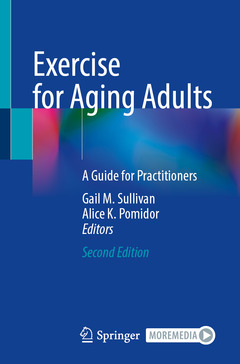Description
Exercise for Aging Adults (2nd Ed., 2nd ed. 2024)
A Guide for Practitioners
Coordinators: Sullivan Gail M., Pomidor Alice K.
Language: English
Subject for Exercise for Aging Adults:
Publication date: 05-2024
182 p. · 15.5x23.5 cm · Paperback
182 p. · 15.5x23.5 cm · Paperback
Description
/li>Contents
/li>Biography
/li>Comment
/li>
Exercise has been rightly termed the ?fountain of youth? for older adults. Exercise is associated with lower risks of developing many chronic conditions (cardiac disease, diabetes mellitus, osteoporosis) as well as being a key treatment modality for common geriatric problems (osteoarthritis, falls, incontinence, sleep issues, frailty). Exercise, or regularly planned physical activity, is also associated with higher functional levels and well-being, which many older adults consider critical for a high quality of life. Indeed, many physiologic changes formerly attributed to senescence appear due to disuse and thus less inevitable than assumed. The dictum of ?use it or lose it? holds true, for people 70 years and older.
This user-friendly text provides practical strategies for health care professionals who work with or advise older adults to create exercise prescriptions suitable for specific settings and medical conditions. Expanded and revised,the second edition translates new findings in exercise research for the elderly for busy practitioners, trainees, students and administrators and provides practical strategies that can be implemented immediately in the common settings in which practitioners care for adults. It includes key points and case examples which showcase the strong evidence supporting exercise by older adults as a key to enhance health, prevent serious outcomes, such as hospitalization and functional loss, and as part of the treatment plan for diseases that are common in older adults. Strategies and exercises are discussed for specific care settings and illustrated via video examples to ensure readers can immediately apply described techniques.
Written by experts in the field, Exercise for Aging Adults is a valuable guide to maintaining quality of life and functional independence from frail to healthy aging adults for physicians, residents in training, medical students, physical therapists, gerontology advance practice nurse practitioners, assisted living facility administrators, directors of recreation, and long-term care directors.
The Physiology of Aging and Exercise.- Benefits of Exercise for Older Adults.-Risks of Exercise for Older Adults.- Types of Exercise: Flexibility, Strength, Endurance, Balance.- Motivational Interviewing for Discussing Exercise with Older Adults.- Writing an Exercise Prescription for Older Adults.- Social and Cultural Influences on Exercise in Older Adults.- Exercises for Adults in Nursing Home and Assisted Living Facilities.- Exercise for Hospitalized Older Adults.- Developing Sustainable Community-Based Exercise Programs for Older Adults.- Exercise Adaptations for Older Athletes.- Exercise Interventions for Pain Management in Older Adults.
Gail M Sullivan, MD, MPH, Professor of Medicine, Associate Director for Education, UConn Center on Aging, University of Connecticut School of Medicine, Farmington, CT, USA
Alice K Pomidor, MD, MPH, Professor of Geriatrics, Department of Geriatrics, Florida State University College of Medicine, Tallahassee, FL, USA
Provides practical strategies for implementing exercise therapy in clinical settings for geriatric patients Includes key points and case examples supporting physical activity as a preventative and management tool Select chapters include video segments demonstrating exercise and interview techniques
© 2024 LAVOISIER S.A.S.



